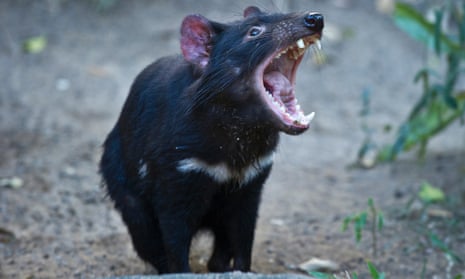Tasmanian devils’ low genetic diversity and previous population declines were driven by climate change rather than hunting or a rampant facial tumour disease, new research has found.
A study of the largest ever genetic dataset of Tasmanian devils found that widespread bounty hunting of the animals after European settlement of Australia is not the primary reason for the species’ worryingly small gene pool. Nor is the devil tumour disease that was discovered in 1996 and has been blamed for a 90% decline in devil numbers in some places.
Researchers found that Tasmanian devils have, in fact, lived with low genetic diversity for thousands of years, having suffered two huge population drops, wiping out around 80% of animals in the past 50,000 years.
The first population slump occurred during the last ice age, around 20,000 years ago, with the next decline occurring 3,000 to 5,000 ago when the climate became much drier. Tasmanian devils were once spread across Australia but are now confined to Tasmania.
The research suggests that climate change is a much larger threat to Tasmanian devils than previously thought, with current warming temperatures and the facial tumour disease raising major concerns over the species’s future.
“Insurance” populations of Tasmanian devils have been established since 2005 in places such as Maria Island in Tasmania, in order to avert the immediate threat of extinction from the facial disease. Tumours are spread between devils when the pugnacious marsupials clash heads while fighting or tussling over food.
However, the paucity of genetic diversity among Tasmanian devils poses a threat as it exposes the animals, which are Australia’s largest carnivorous marsupials, to a greater risk of disease.
Anna Brüniche-Olsen of the University of Tasmania, who led the research, said devils are “very susceptible” to climate change.
“When the climate became more arid with more scrub and grass, it really impacts [on] their numbers,” she told Guardian Australia.
“Tasmanian devils are facing a real extinction threat. Tumours are the here-and-now threat and climate change is the next big threat. Given the impact a more arid climate has had on devils in the past, we should be really worried.
“The genetic diversity is really low at the moment, which is always a risk because if a disease spreads there is less potential for the devils to adapt. That’s why it’s important that their numbers are managed to conserve as much genetic diversity as possible.”
The researchers, from the University of Tasmania and University of Adelaide, used genetic markers to compare genes across individual Tasmanian devils. Once genetic diversity is identified, researchers can build ancestral trees that can allow estimates of previous populations.

Comments (…)
Sign in or create your Guardian account to join the discussion